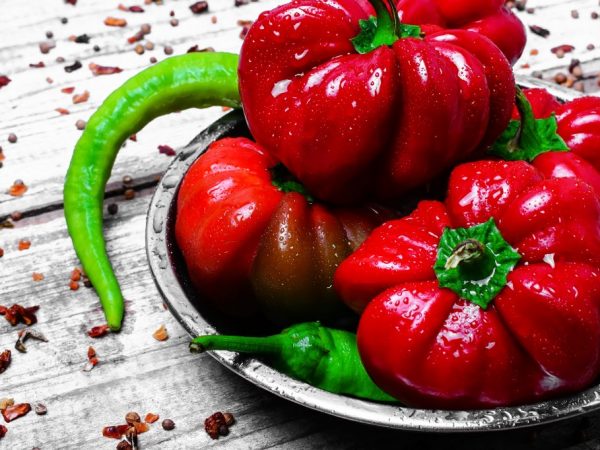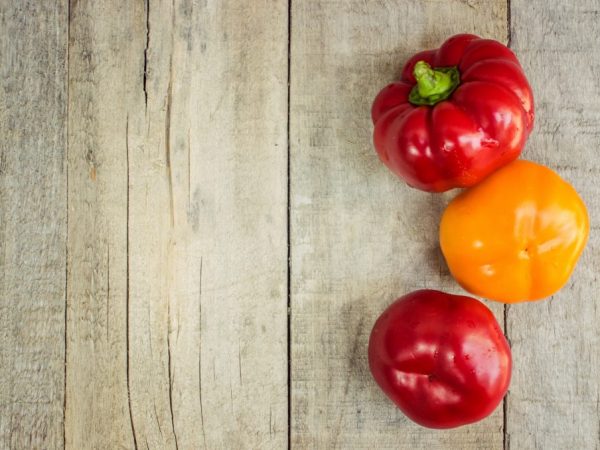Characteristics of the Ratunda pepper variety
Ratunda pepper is described as highly resistant to disease, has a long shelf life and good yields. The vegetable is similar in color to bell pepper, but differs in shape.

Characteristics of the Ratunda pepper variety
Characteristics of the variety
The Ratunda pepper variety has a good yield. In the first 2 years of life, gardeners recommend harvesting half-ripe fruits (with a characteristic brown tint), allowing them to reach maturity in storage with a moderate temperature.
In order for the seeds to grow, they adhere to a temperature regime within 20 ° C. Ratunda is a mid-season type of pepper. From the moment of planting to harvesting the fruits, it takes about 4 months.
Description of Ratund pepper:
- good productivity;
- demanding seeds for high temperature;
- long-term storage;
- a small degree of damage during transportation;
- low calorie value;
- high content of nutrients.
A distinctive feature of Ratunda is unpretentiousness in the choice of neighbors. It can grow unhindered alongside bitter varieties, but excessive pollination can result in a hybrid with spicy fruits.
Description of the bush
According to the description, the variety is a short, compact plant, sprouting in the form of a bush, the height of which can reach 60 cm.
The plant has an oblong, thick stem and elongated rounded leaves. The bush does not need props, but it requires high soil fertility rates.
Description of the fetus
Ratunda fruits are slightly flattened and have an unusual rounded shape, which slightly resembles a pumpkin. Unripe vegetables are green in color, while fruits that have reached ripeness have a dark red hue.
The walls are rather fleshy, their thickness can reach 8 mm or more. The fruits have a ribbed surface.
The vegetable has a fairly large weight - 150-180 g. In addition to red, yellow and green, there are fruits of pink and purple colors. The delicate and sweet flesh makes them an excellent ingredient for a wide variety of dishes.
Care

Peppers are planted only with seedlings
The culture is grown by seedling method. Sowing seeds begins at the end of February, the soil for this variety should be fertile, absorb well and allow moisture to pass through.
Soil and seed preparation
For good growth of seedlings, a soil supplement is made before planting: manure, earth and river sand are mixed. Planting usually begins in early summer, after a spring frost. In order to disinfect the seeds before planting, they are kept in a weak solution of manganese for about 15 minutes.
Seedlings are watered with exclusively heated water and as the soil dries out. When the first leaves appear on the shoots, they are dived into large pots, but carefully, since the roots of young plants are easy to damage.
To grow Ratunda peppers, they begin to prepare the soil a year before planting. There are up to 10 kg of fertilizer per 1 m². In the spring, add 40 g of nitrate to the soil surface. If the plant does not have enough phosphorus, the fruit will slow down in growth and ripen unevenly.
Ratunda belongs to undersized varieties of bell pepper, therefore, 6 shoots should be planted per 1 m² with an interval of 30 cm and a distance between rows of 75 cm. The root collar of a plant cannot be buried in the ground, as this is fraught with decay.
Growing rules
Cultivation of a crop depends on compliance with the basic rules of care:
- Watering. Irrigation of a vegetable is carried out only under the root and with pre-warmed water. In case of a lack of water, the plant discards the formed ovaries, with excessive watering it begins to hurt.
- Soil mulching. Loosening can easily damage the roots on the soil surface, therefore mulching is performed. When mulching, the roots of the pepper remain intact, air exchange is maintained in the soil.
- Garter. To avoid breaking the branches, they are tied up.
It is necessary to attract pollinating insects to the site. This should be done during the flowering of the bush by spraying it with a sugar solution. Also, an excellent result is given by feeding with organic fertilizers.
Observance and implementation of all the rules of care will allow you to get a high-quality crop from the plant.
Diseases
Diseases to which Ratund pepper is susceptible:
- Fusarium. Sudden changes in temperature and excess moisture can cause fusarium disease. When affected by this disease, the leaves quickly fade and acquire a light yellow color. Bushes prone to the disease cannot be saved - they are removed, and the soil is treated with a mixture of manganese. For the surviving bushes, a favorable temperature is set and the amount of watering is reduced. Also, for the purpose of prevention, the plant is treated with special preparations.
- Wet rot. Initially, it is a small spot, which subsequently spreads and occupies almost the entire surface of the fruit. Infection occurs through seedlings, soil or water. The skin of the vegetable dries up, it becomes soft and watery. For prevention purposes, the plant is sprayed with a solution of copper sulfate.
- Stolbur. When affected by this disease, the leaves begin to wither and curl. Growth stops, ripe fruits become concave. The disease is carried by ticks and aphids. To get rid of the disease, the infected fruits are completely destroyed, and then the seedlings and seeds are disinfected before planting.
Pests
The most dangerous insects are slugs, aphids and wireworms. The first pest is a slug. The insect eats leaves and fruits, and also provokes rotting. Loosening of the soil helps to resist the insect.
Aphids settle on the leaves, as a result of which they curl and wither. She spoils the harvest and drinks the sap of the plant. To combat aphids, the bushes are treated with a solution of ash and liquid soap.
The wireworm is a yellow-brown larva with a hard body. The larva eats roots and causes significant harm to fruits; it can live in the soil for several years. To get rid of the pest, a deep digging of the earth should be carried out, as a result, the wireworm will die from the cold.


